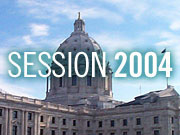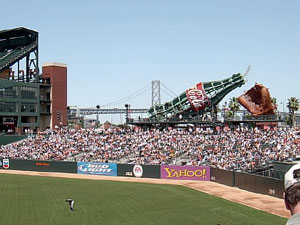Audio
Photos
Resources
Your Voice
| ||||||||||||||||||||||||||||||||||||||||||||||||
In San Francisco, the Giants went private for their stadium
May 14, 2004
With the prospects for a new publicly subsidized stadium fading yet again, the financing puzzle for the Minnesota Twins remains unsolved. It's much the same position the San Francisco Giants found themselves in. But after voters rejected public financing four times in the 1980s and 1990s, the Giants financed their new park largely on their own. Since 2000, Barry Bonds and the rest of the Giants have played to a consistently packed house in one of baseball's premier parks. But that doesn't mean San Francisco's privately-financed stadium honeymoon will last forever.
San Francisco, Calif. — Marty and Gordon Palmquist are like a lot of San Francisco baseball fans -- happy to see a game in a fancy new park even if they once disagreed about who should pay for the stadium.
The Palmquists are charter season ticket holders at SBC Park, known as Pac Bell Park until this season. As they watched the Giants take batting practice before a recent afternoon game against the Florida Marlins, Gordon Palmquist said he always voted against public subsidies for the Giants.
"Why would we use tax money if they could get people to invest money, private money?" said Palmquist. "They make profit on it, and that's good. I wanted it to go private, and it did."
 | |||
A publicly-financed stadium would have been fine with Marty Palmquist, who said the higher taxes would have been worth it. But for her, the stadium debates are distant memories now that the intimate, sunny SBC Park on San Francisco Bay has replaced the impersonal, chilly, foggy and blustery Candlestick Park, where the Giants played until 1999.
"I love the new park, and I'm glad it's sold out almost every time they play," she said. "Not only the location, but that fact that we don't have all that wind? It's wonderful."
There just weren't enough Marty Palmquists for the Giants to get a taxpayer-funded stadium. Owners tried four times over two decades for a large public subsidy to pay for a new park, but each time voters rejected them, once by only 2,000 votes.
The Giants had hit the wall. In 1993, the team was sold to new owners who said they were committed to head off a move to another city.
"We found that the only way that a ballpark was going to be built in San Francisco is if the Giants were to do so privately," said Stacy Slaughter, Giants vice president.
While the team fought long and hard for a handout, Slaughter said paying for the stadium on its own has been, for the most part, a good deal. Without the layers of bureaucracy that would have come along with public money, the Giants were able to get the design they wanted, to complete the stadium on time and under budget, and are free to rent the park for rock concerts, college football bowl games, and monster truck rallies.
|
We found that the only way that a ball park was going to be built in San Francisco is if the Giants were to do so privately.
- Stacy Slaughter, San Francisco Giants vice president |
"We are paying more for our stadium than most other teams do," said Slaughter. "We have an annual debt payment that we have to pay. But at the same time, other teams around the league are paying rent for their stadiums in excess of several million dollars. And they don't necessarily generate the revenues we do. So at the end of the day it's pretty much a wash."
SBC Park cost $315 million. After selling the naming rights for $50 million and raising about $90 million through personal seat licenses and corporate sponsorships, the Giants borrowed $175 million for construction. The team pays about $17 million annually to service that debt, and will for another 15 years.
So far the Giants have had no trouble paying their stadium debt. A post-season regular the last few years, the Giants have 28,000 season ticket holders and regularly sell out their games.
Quentin Kopp opposed public financing for a new Giants stadium as a member of the San Francisco Board of Supervisors, and later as state senator. But he led the charge for a successful ballot initiative which promised the Giants would build a stadium on their own. He says the way the new park was built proves the value of private enterprise.
"From the standpoint of the integrity of taxpayer money, that simple notion of letting public monies be used for police, fire, the other regular services of local government, has been preserved -- not using those monies to pay for an enterprise that's able to generate its own profits," Kopp said.
While the team did pay for construction of SBC Park, it also benefited from significant public contributions. The park sits on city-owned property at the foot of the San Francisco-Oakland Bay Bridge, near downtown. It's probably some of the most expensive real estate in the country, and the Giants get to use it for free. The city also kicked in $80 million in infrastructure improvements.
Joel Ventresca headed up a citizens group called "Committee to Stop the Giveaway," which opposed public financing of a baseball stadium in San Francisco. He says residents are paying indirect costs -- for city services to the park, and the loss of land that could be used for housing or industry that would generate more tax dollars than baseball.
"For PR purposes they claim it's privately financed," said Ventresca. "In reality when you look at the hard numbers, the stadium in San Francisco is heavily subsidized by the local taxpayers. And that means tax dollars are going to support this sports team and their sports palace instead of those tax dollars going for public education, public parks or other types of high-need services that exist here in San Francisco."
It's a mistake, agrees Stanford University economist Roger Noll, to think of SBC Park as purely private. Noll, who studies sports economics, says the Giants' $175 million investment is paying off for now because the park is bringing in more than enough money to cover debts. But Noll sees signs the new-park honeymoon may be coming to an end. The Giants are having an off year on the field, and for the first time some games are not being sold out. Noll says trouble looms.
"Most likely, as one gets out past 10 years, the interest costs will in fact exceed the revenue enhancement," said Noll. "The reason teams have in fact asked for public subsidies is that these stadiums aren't worth it. They actually cost more than the incremental revenues they generate over their lifetimes. And that's why they go for public subsidies. It's not really a good business investment over the long run."
Noll says that means the Giants could come calling on taxpayers again when SBC Park turns from asset to financial burden. But as for the present, Noll says there's a lesson to be learned from San Francisco for cities struggling with stadium issues.
"If the political system refuses to provide a large subsidy, as happened in San Francisco when the Giants lost four consecutive ballot measures to get a subsidy, then it may be the case that the team will find alternative sources of financing to pay for most of the stadium," he said.
The problem with that strategy, said Noll, is that more cities want baseball teams than there are baseball teams. Force a team to go private and you may lose it to another city -- if that city is willing to provide a big taxpayer subsidy. In the current market, though, there doesn't appear to be a surplus of cities willing to pay the price.
In Missouri, the Legislature took the risk, rejecting a bid by the St. Louis Cardinals for a hefty subsidy for a new stadium. Like the Giants, the Cardinals are paying for a new stadium mostly on their own. St. Louis-based sports economist Patrick Rishe said St. Louis and San Francisco could spell the end of the massive public stadium subsidies of the 1990s.
"I think it's going to be harder and harder for any team to expect to get, say, over two-thirds of their funding -- or even 50 percent of their funding -- say through a sales tax," Rishe said.
For their part, the Minnesota Twins say the level of private financing seen in St. Louis and San Francisco is not feasible in the Twin Cities. The team points out that San Francisco benefited from the dot-com boom when the city was awash in money; and that the Cardinals already own land where the stadium will be built, and have much higher attendance than the Twins.
|
News Headlines
|
Related Subjects
|


